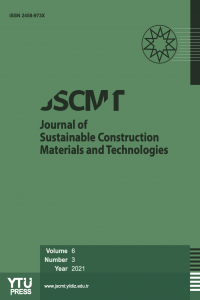Binalarda enerji performansının arttırılması amacıyla kullanılan yalıtım malzemelerinin Net bugünkü değer yöntemi ile maliyet analizi
Net Bugünkü Değer, , yalıtım malzemesi, maliyet etkinlik, binalarda enerji performansı
Cost analysis of insulation materials used to increase energy performance in buildings with Net Present Value method
Cost-effectiveness, energy performance of buildings, insulation material, Present Net Value,
___
- 1. The European Parliament and the Council of the European Union. (May 19, 2010). European Parliament and the Council of the European Union. Official Journal of the European Union, 153/13–153/25. https://eur-lex.europa.eu/LexUriServ/LexUriServ. do?uri=OJ:L:2010:153:0013:0035:en:PDF
- 2. Aşikoğlu, A., Altin, M., & Bayram, N. S. (2021). Application of the passive house certification system in existing buildings: enerphit certification system. Afyon Kocatepe University International Journal of Engineering Technology and Applied Sciences, 21(5), 1146–1156. [Turkish]
- 3. Bakar, N. N. A., Hassan, M. Y., Abdullah, H., Rahman, H. A., Abdullah, M. P., Hussin, F., & Bandi, M. (2015). Energy efficiency index as an indicator for measuring building energy performance: A review. Renewable and Sustainable Energy Reviews, 44, 1–11. [CrossRef]
- 4. Mohsen, M. S., & Akash, B. A. (2001). Some prospects of energy savings in buildings. Energy Conversion and Management, 42(11), 1307–1315. [CrossRef]
- 5. Füchsl, S., Rheude, F., & Röder, H. (2022). Life cylce assessment (LCA) of thermal insulation materials: a critical review. Cleaner Materials, 5, Article 100119. [CrossRef]
- 6. Schiavoni, S., Bianchi, F., & Asdrubali, F. (2016). Insulation materials for the building sector: A review and comparative analysis. Renewable and Sustainable Energy Reviews, 62, 988–1011. [CrossRef]
- 7. Kumar, D., Alam, M., Zou, P. X., Sanjayan, J. G., & Memon, R. A. (2020). Comparative analysis of building insulation material properties and performance. Renewable and Sustainable Energy Reviews, 131, Article 110038. [CrossRef]
- 8. The European Parliament and the Council of the European Union. (Dec 16, 2002). Directive 2002/91/EC of the European Parliament and of the Council of 16 December 2002 on the energy performance of buildings. Official Journal of the European Communities, L 1/66–L 1/71. https://eur- lex.europa.eu/LexUriServ/LexUriServ.do?uri=O- J:L:2003:001:0065:0071:en:PDF
- 9. Turkish Standard. (2013). TS 825 Thermal insulation in buildings. Turkish Standard Institution. [Turkish] [10] Danaci, H. M., & Akin, N. (2022). Thermal insulation materials in architecture: a comparative test study with aerogel and rock wool. Environmental Science and Pollution Research, 29(48), 72979–72990. [CrossRef]
- 10. Kulaksızoğlu, Z. (2006). Isı yalıtım sektör araştırması. Türkiye İstatistik Kurumu Ankara Bölge Müdürlüğü. [Turkish]
- 11. Hall, M. R. (Ed.). (2010). Materials for energy efficiency and thermal comfort in buildings. Elsevier. [CrossRef] [13] Ülker, S. (2009). Isı yalıtım malzemelerinin özellikler- inin uygulamaya etkileri [Doctoral Dissertation]. Istanbul Technical University Institute of Science and Technology. [Turkish]
- 12. Arslan, M. A., & Aktaş, M. (2018). Evaluation of insulation materials used in construction sector based on heat and sound insulation. Journal of Polytechnic, 21(2), 299–320. [Turkish]
- 13. Fard, P. M., & Alkhansari, M. G. (2021). Innovative fire and water insulation foam using recycled plastic bags and expanded polystyrene (EPS). Construction and Building Materials, 305, Article 124785. [CrossRef]
- 14. Zhao, Z., Yang, X., Qu, X., Zheng, J., & Mai, F. (2021). Thermal insulation performance evaluation of auto- claved aerated concrete panels and sandwich panels based on temperature fields: Experiments and simulations. Construction and Building Materials, 303, Article 124560. [CrossRef]
- 15. Qu, X., & Zhao, X. (2017). Previous and present investigations on the components, microstructure and main properties of autoclaved aerated concrete–A [22] review. Construction and Building Materials, 135, 505–516. [CrossRef ]
- 16. Thongtha, A., Maneewan, S., Punlek, C., & Ungkoon, Y. (2014). Investigation of the compressive strength, [23] time lags and decrement factors of AAC-lightweight concrete containing sugar sediment waste. Energy and Buildings, 84, 516–525. [CrossRef]
- 17. Republic of Türkiye Ministry of Environment, Urbanization and Climate Change. (Feb 01, 2023). [24] 2023 yılı inşaat ve tesisat birim fiyatları. https://web- dosya.csb.gov.tr/db/yfk/icerikler/2023-b-r-m-f-yat- lari-1-20230130125553.pdf [Turkish]
- 18. Büker, S., Aşıkoğlu, R., & Sevil, G. (2018). Finansal [25] yönetim. Sözkesen Press. [Turkish]
- 19. Storesletten, K. (2003). Fiscal implications of im- migration—A net present value calculation. The Scandinavian Journal of Economics, 105(3), 487– 506. [CrossRef]
- 20. Žižlavský, O. (2014). Net present value approach: method for economic assessment of innovation projects. Procedia-Social and Behavioral Sciences, 156, 506–512. [CrossRef]
- 21. Central Bank of the Republic of Türkiye. (Feb 18, 2023). Reeskont ve avans faiz oranları. https://www. tcmb.gov.tr/wps/wcm/connect/TR/TCMB+TR/ Main+Menu/Temel+Faaliyetler/Para+Politikasi/Re- eskont+ve+Avans+Faiz+Oranlari [Turkish]
- 22. Kono, J., Goto, Y., Ostermeyer, Y., Frischknecht, R., & Wallbaum, H. (2016). Factors for eco-efficiency improvement of thermal insulation materials. Key Engineering Materials, 678, 1–13. [CrossRef]
- 23. Revenue Administration. (Feb 02, 2023). Redemp- tion rates. https://www.gib.gov.tr/sites/default/files/ fileadmin/user_upload/Yararli_Bilgiler /amortis- man_oranlari.pdf [Turkish]
- Başlangıç: 2016
- Yayıncı: Yıldız Teknik Üniversitesi
Bakam Vision A, Mbimda Ali MBİSHİDA, Timothy DANJUMA
Bentonit Tabanlı Çinko Komplekslerin Sentezi ve Karakterizasyonu
Gülsüm Ece ANAVATAN, Elif ANT BURSALI, Mürüvvet YURDAKOÇ
A Review on Blockchain Operations in Construction Management
Bassant SAYED, Hasan Volkan ORAL
Yüksek Dayanımlı Hafif Beton Paneller Kullanılarak Dolgulu Betonarme Çerçevelerin Güçlendirilmesi
Yüzeylere Uygulanan Antimikrobiyal Boyalar için Zaman Çizelgesi Yaklaşımı
Effects of Bamboo Leaf Ash on Alkali-Silica Reaction in Concrete
